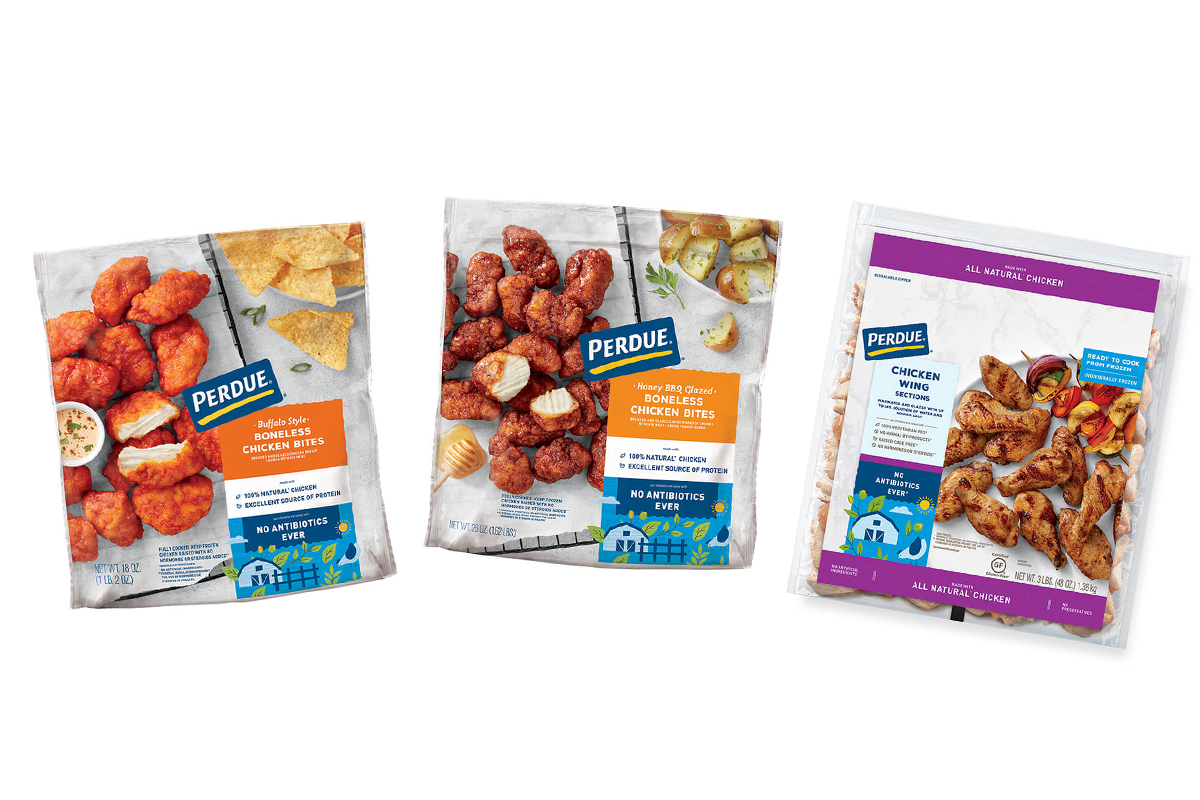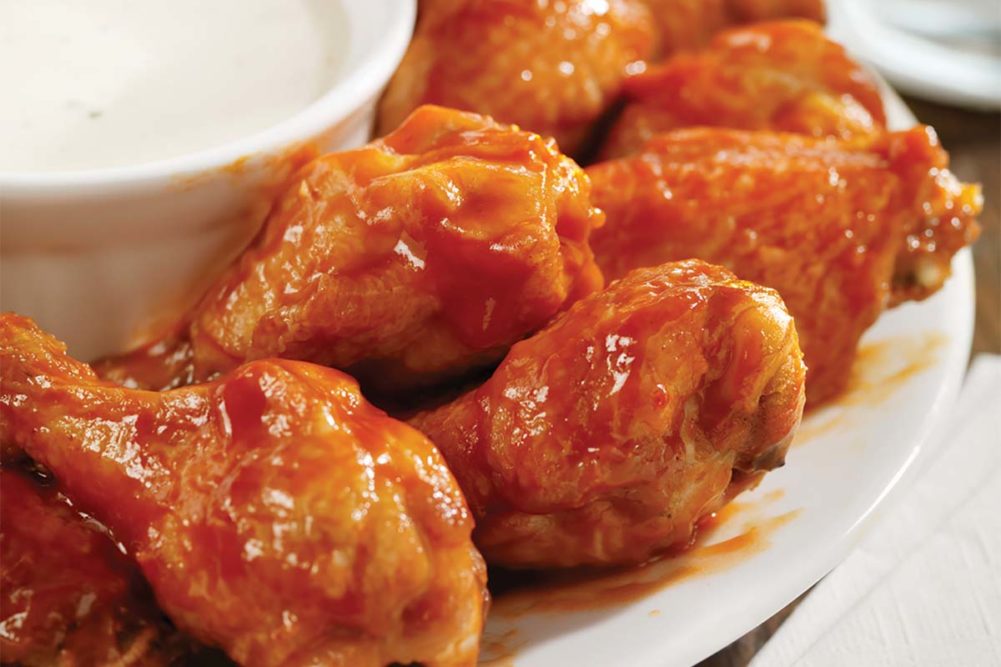The skinless, boneless chicken breast makes the most money for chicken processors, and most likely always will, but what is, or what was, essentially a by-product of processing chickens, the wing, has become an extremely important part of chicken processors’ sales profile. The National Chicken Council (NCC), Washington, DC, estimated the marketing of approximately 32.5 billion chicken wings in 2022.
“The vast majority of wings, especially those destined for restaurants, are disjointed, with the third joint, the thin part known as the wing tip or flapper, being exported to Asian countries and the meatier first and second joints being sold domestically,” said Tom Super, senior vice president of communications at NCC. “The two segments or portions are known as the ‘drumette’ and the ‘flat,’ as opposed to the whole wing. So, each chicken produces four wing segments.”
Super said the popularity of chicken wings began in the 1980s when instead of cooking the whole bird, a trend in the 1960s and 1970s, US consumers began to gravitate toward boneless, skinless breast meat. Wings became inexpensive to process at that time and restaurants and bars found they could charge lower prices for the relatively inexpensive wings, and due to the nature of spicy and salty flavors, they discovered beer sales increased significantly when customers ate wings.
Wing wants
Wayne-Sanderson Farms, headquartered in Laurel, Miss., operates four production lines that process bone-in chicken wings with capabilities for fully cooked roasted wings, steamed, breaded and ready-to-cook breaded. Chicken wing production represents approximately 20% of Wayne-Sanderson’s total business.
“Much of our volume goes into foodservice distributors and operators,” said Tom Bell, vice president of prepared foods at Wayne-Sanderson Farms. “We are also expanding our supermarket deli applications.”
Bell said the No. 1 thing his company’s retail and foodservice customers look for from a wing supplier is taste. Beyond that, customers and consumers demand reliable, consistent sizing, high moisture retention and breading coverage. A large variety of flavors and styles ensures customers can always purchase based on the consumers’ taste preferences as well.
“We have three different products in our Crispy Fliers line of products, Mild, Spicy and our new Honey,” Bell said. “Our Flying Saucer line of products includes both jumbo and small steamed and roasted wings, and Buffalos have been a staple for Wayne-Sanderson Farms for many years and continue to exceed customers’ expectations. It is a fryable buffalo flavored wing.”
Perdue Farms, Salisbury, Md., supplies chicken wings to many channels and emphasizes processing enough variety to meet its customers’ needs and wants. John Moore, senior marketing manager at Perdue Farms noted that in addition to different flavors, different sizes also appeal to different channels when selling chicken wings.
“We offer customers and consumers medium and jumbo-sized wings,” he said. “Specific products available for purchase on our direct-to-consumer website, PerdueFarms.com, include fresh whole chicken wings, a chicken wings party pack, individually frozen chicken wing sections and Boneless Chicken Wyngz in Honey BBQ and Buffalo. Our most popular wings flavors / varieties are buffalo, roasted and lightly breaded.”
Sometimes customers get requests from consumers and whether it be a specific thing or just a change in trends, those requests are passed on to processors. Sizes, flats or drumsticks and flavors all change with time. The key thing for processors, their customers and the consumer when looking for change in the supply is always communication. When working on a new line of wings for whomever might be making the request, working together is paramount.
“Perdue has a long history of listening to our customers and consumers and developing convenient products that meet their needs to bring simplicity and high-quality, premium protein to their lives,” Moore said.
Flavor trends and cooking attributes (fry or bake) are major factors in processors and customers working to develop new varieties and new lines of chicken wing products.
“We work closely with our customers to create new and innovative products that meet their demand,” Bell said.
 Perdue Farms' chicken wings are offered in a variety of flavor profiles and are available in boneless and bone-in options. (Source: Perdue Farms)
Perdue Farms' chicken wings are offered in a variety of flavor profiles and are available in boneless and bone-in options. (Source: Perdue Farms)
Chicken wing challenges
When processing wings, processors encounter many challenges. Perdue Farms cites regionality as one of its most significant challenges. Producing wings for many different regions of the country, and the world as well, means processors and their customers must process not only flavor varieties more popular in certain regions, but also take into consideration other factors that change from place to place.
“We’ve found that customers and consumers in the Northeast tend to prefer large wings while those on the West Coast prefer smaller wings,” Moore said.
Wayne-Sanderson saw a serious decrease in operators completely removing wings from their menu last year when the price of wings increased significantly (see sidebar, Page 35). While the company has started to see wings making a return, it has been at a much slower pace than expected.
Bell added, “Supply is always challenging. Using only fresh wings keeps us close to production planning, based on timing constraints.”
As the wing business has grown, evolved and gained popularity, the processes have also evolved. Processors have overcome and continue to address key differences in the operations between processing wings and other parts of the chicken.
“We balance the web [flat] and drum proportions to insure we meet customer demand,” Bell said. “Wings are obviously much smaller than eight-piece cut up and cook quicker to allow higher throughputs.”
According to Moore, chicken wings are more fragile and require more care than regular chicken cut up as well.
He added, “Compared to other parts of the chicken, wings tend to bruise and break, meaning they require more grading.”
Overcoming obstacles
Automation has always factored into poultry processing. Once wings began to gain popularity in the 1980s, automation became an integral part of processing given the increased volume needed to accommodate higher consumer demand.
“Today, the production of wings is an automated process, which allows us to consistently provide our customers and consumers with high-quality wing products,” Moore said.
Automation has also helped with the general labor pool, as well as the skilled labor pool, slowly evaporating over the years, and recently, becoming a serious dilemma in the processing industry. More and more processors have moved to automation wherever they can. For Wayne-Sanderson Farms and its wing processing, this has come in the form of preparing chicken wings for shipment.
“Pack out automation has been a big help in reducing some labor challenges,” Bell said. “Having qualified technicians is paramount to keeping the robotics working.”
Regardless of the challenges involved with chicken wings, the popularity shows no signs of slowing down anytime soon. On Feb. 1, 2023, the National Chicken Council projected Americans would consume a record-breaking 1.45 billion chicken wings during Super Bowl LVII weekend, an increase of 2% (equal to 84 million wings) over the previous year’s report.
“The two main reasons are more favorable prices and more people getting back to normal and gathering for the Big Game, whether at home or at a bar/restaurant,” Super said. “While Americans are seeing inflation impact almost every part of their lives, both wholesale and retail wing prices are down double digits from a year ago, according to USDA, and consumers are seeing a lot more features and promotions.”
During the rest of the year the affordability, adaptability, flavor options and status as a comfort food, make them a staple at celebrations, gatherings of family and friends, and sporting events beyond just the Super Bowl. Wings also offer ease of preparation and variety in the home.
“Consumers can easily enjoy restaurant quality wings at home with very little clean up in just 20 minutes with an air fryer,” Moore said. “I really enjoy using a buffalo or ranch seasoning when air frying wings at home but my absolute favorite way to cook them is with everything bagel seasoning.”
Bell said that the flavor, ability to be easily transported and makeup of the wing itself makes it popular. Wings are versatile and forgiving throughout the coooking process while providing a base that anyone from chefs to backyard barbecuers to the average person in the kitchen can work from.
“Wings travel well, and the skin/fat content help make them popular,” he said. “It also lends itself to many sauces or rubs.”
Super added, “If we could just find that chicken with four wings.”



